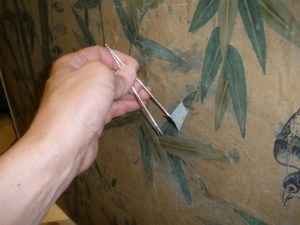Handpainted Chinese Paper, 18th Century
Before restoration
Wanamaker Mansion
Beautiful antique Chinese wallpaper covered the walls of the library in the former Wanamaker mansion in New York City. This wallpaper dates from the late 18th century or early 19th century and is entirely handpainted. When the current owner, a private school, planned to renovate the library into a classroom, they sought to preserve the wallpaper for reuse in the school.
Inspecting the paper
John Nalewaja and Jim Francis inspected the condition of the wallpaper and then formed a plan for removal, restoration and reinstallation.
Damaged section of paper
They discovered that while it would be possible to remove and restore the wallpaper, a few of the panels had been damaged over the years and would require extensive cleaning and restoration.
Revealing true colors
The bamboo frames surrounding the wallpaper were removed and the wallpaper was carefully separated from the walls, panel by panel and all panels were labeled for later reinstallation.
Surprisingly, when John and his assistants removed the bamboo frames surrounding the wallpaper, they discovered that the original background color of the paper was a beautiful blue. During restoration, the artist reproduced this blue throughout the panels.
The old backing materials were painstakingly removed from the panels, prior to restoration and reinstallation. After removal, the antique Chinese paper was installed on boards which had been fabricated to fit the new space exactly. This ensured that the delicate antique paper could be reinstalled successfully. The plan also called for the reinstalled wood paneling in the classroom to precisely allow for the newly created boards.
After removal, before restoration and reinstallation
Confirming original colors
Once the boards were prepared, the antique paper was applied. At this time, all loose areas were carefully secured again, including even the tiniest of pieces. When John lifted an applique from a long-ago repair, he found further confirmation of the original hues of the wallpaper.
After the boards had cured, the restoration process began. John and his assistants cleaned and repaired every panel. Some panels required only minimal touch up, but some panels had missing paper which had to be recreated. Finally, every panel had been restored. The original artwork of the paper, trees, birds and flowers was fairly intact, but when the blue background was restored, the details became much more prominent again.
Boards, mid-restoration
The picture above shows the boards in the midst of restoration. John and his assistants carefully pieced together the best of the panels and installed them on separate boards to fit into specific areas of the new classroom.
After restoration
Some small cutouts from leftovers of the paper were made into 5x5 inch boards which were given as gifts to donors who supported the project.
After the artwork was completed, the boards with the antique Chinese wallpaper panels were ready to be installed in the new classroom. Once John and his assistants hung the boards, the installation looked original to the space. The original beauty of this valuable antique wallpaper had been uncovered and it could be enjoyed again for generations to come.
After restoration and reinstallation
Country House in Upstate New York
Before restoration
A client called after purchasing a set of beautiful handpainted Chinese wallpaper panels, which had been hung in a country house in upstate New York years ago. John and Jim inspected the paper and determined that while it would require some restoration, it could be successfully reinstalled again.
They noted at the time that it was very similar to the restored antique Chinese paper in the Wanamaker mansion. In particular, the handpainted birds were almost identical.
As John and his assistants began working with the wallpaper in the studio, they gradually realized that it was more than similar to the Wanamaker paper, it was indeed the same antique, hand-painted Chinese wallpaper, a stunning coincidence. In fact, it was the bottom half of that wallpaper.
The handpainted paper had originally been fabricated in 14' panels in China in the late 18th century or early 19th century. Perhaps at the time of sale in the United States, the panels were cut in half and used in two different locations. The second set of panels, the bottom of the paper, was especially interesting as it included a scene with people. Although not without precedent, this was a bit unusual for Chinese scenic papers of the period.
Scene from the bottom of the paper
The paper was prepared for reinstallation and the restoration process began. This set of papers was not as badly discolored as the original set of panels, but apparently the paper had been stored for quite a while and was damaged during storage. All worn or damaged sections of the paper were repaired and then the restoration artist touched up the artwork as required. The overall hue of this paper was brighter than the top half and probably gives a truer sense of the original background color of the paper.
After restoration, John then installed this beautiful paper in a lovely, light-filled dining room. It was featured in Architectural Digest.
Installation in upstate New York, after restoration
See more of our Antique Wallpaper restorations here.















